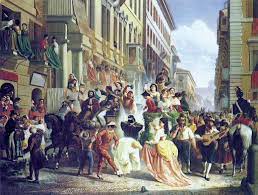Italy: The story of Rome’s carnival – Carnevale Romano

Rome: The first certain traces of Rome’s carnival celebrations date back to the 12th century.
The ludus carnevalarii saw the attendance of the pope since 1143, with events based in the fields below Monte dei Cocci in Testaccio.
Festivities included duels and bullfights, attended by noble families as well as ordinary citizens of Rome, keen to witness the wild events as well as take advantage of the meat from the slain animals.
Rome’s carnevale festivities were later moved into the city centre to venues such as S. Pietro, Piazza Farnese and – in particular – Piazza Navona.

However it was with the arrival of the flamboyant Pope Paul II in 1464 – and his move to live at Palazzo S. Marco near Piazza Venezia – that Rome’s carnival really took off.
Festivities were based in the centre with races being held along Via Lata – today Via del Corso – with categories including children, elderly, donkeys and buffaloes, all competing for handsome prize money.
Over the centuries the carnival had its ups and downs, all depending on the scruples of the reigning pope: some pontiffs allowed Romans to revel in excess, others repressed the festivities.
Pope Alexander VI Borgia, who enjoyed Carnevale immensely, established a special race for prostitutes in 1501.
Two Carnevale events were particularly popular: the inaugural parade and the race of the Berber horses, both based in Piazza del Popolo and along Via del Corso.

In the days preceding these events noble families would display their splendid carriages, throwing flowers and sugared almonds to the assembled crowds.
The pope attended the inaugural parade, in a pomp-filled procession designed to show his power.
However the most anticipated event of the Carnevale Romano was the race of the Berber horses, a wild and dangerous spectacle along Via del Corso, where crowds celebrated with colourful masks and extravagant displays of fireworks.
The Berber horse race was abolished in 1874 by King Victor Emmanuel II due to the death of a spectator, resulting in Rome’s carnival celebrations falling into oblivion for over a century, until their revival in recent years.
Italy’s covid-19 restrictions have put a dampener on carnival celebrations in Rome over the last two years.
The programme of events is usually organised by the Carnevale Romano association however no events have been announced yet for 2022.
This year’s carnevale season begins officially on Sunday 13 February, on the eve of Valentine’s Day and will continue until Sunday 1 March.
During this time of year it is common to see children in Rome dressed up in fancy costumes and throwing colourful confetti, with bakery windows full of special carnival treats such as frappe and castagnole.
Key dates on the carnevale calendar are 24 February (Giovedì Grasso), 27 February (domenica di Carnevale) and 1 March (Martedì Grasso).
Traditionally carnival is the period of fun and festivities preceding the 40 days of fasting and prayer that Christians observe during Lent, which begins this year on 2 March, with Ash Wednesday.





